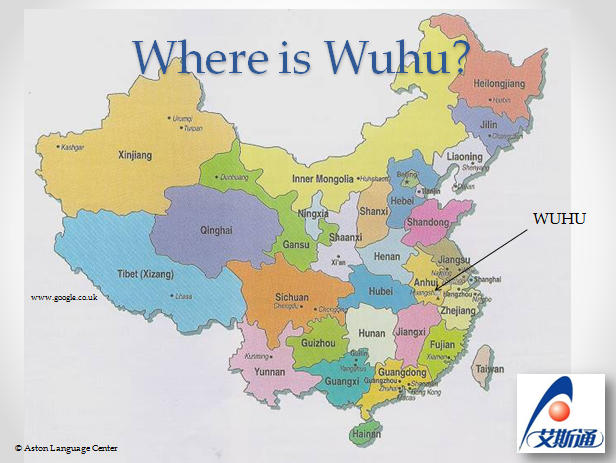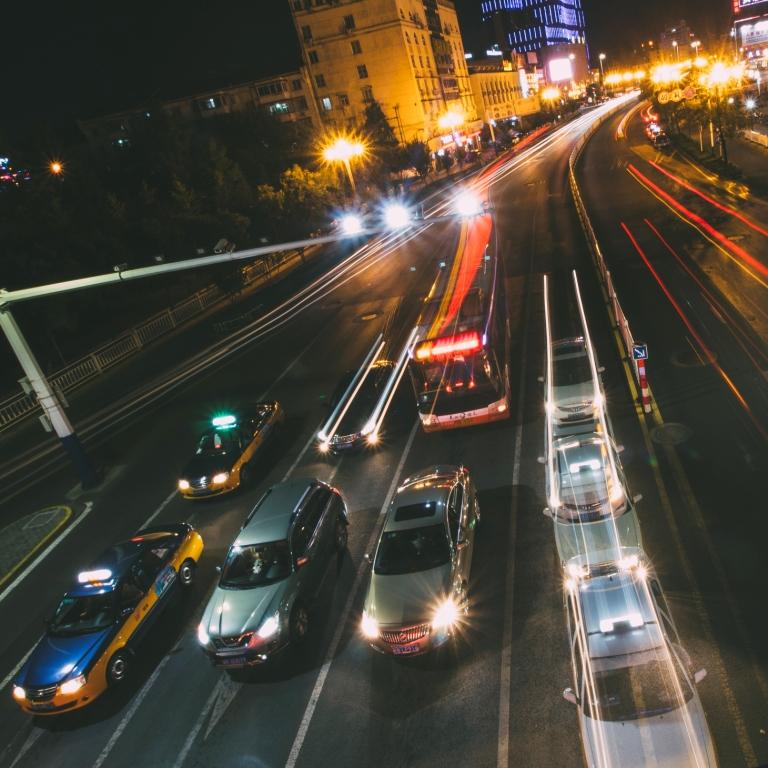Aston and Wuhu

Aston International Education LTD
Aston International Education LTD is a language school which was founded in 2001 with the aim of providing high quality and affordable language courses to local Chinese students. Today, Aston is well-established with three branches and over 10 partner schools in Anhui Province. The growth of the school has seen Aston teach more than 10,000 local Chinese students a year ranging in age from 3 to 62, as well as offering a number services for foreign students who wish to learn Mandarin, Chinese culture and experience life in China.
Teaching at Aston
In China, there is an enormous and rapidly growing demand for learning English and other foreign languages including French, German, Japanese and Korean. Aston meets this demand with the provision of language courses taught by foreign teachers recruited from countries in Europe, Australia, New Zealand and North America. The school provides all teaching materials and students receive a textbook that teachers are expected to work through with the addition of their own activities and games aimed at improving spoken English. Teachers plan lessons according to their own style and class, which vary in size and age group, ranging from 6 to 16 pupils and aged 3 and upwards. The normal teaching schedule is 80 hours over four weeks (40 hours for part-time teachers), with any extra hours you agree to work being paid at an overtime rate detailed in the employment contract. The busiest days are weekends, when classes for primary to secondary school students are held. On weekday evenings beginner and intermediate adult classes are taught. From Monday to Friday, teachers work in the local schools, colleges or companies with larger class sizes. For classes in which the student’s English comprehension is low a Chinese assistant will work as translator. Students are well behaved and accustomed to stricter teaching practices and larger class sizes than in Western education systems.Teachers are therefore expected to approach their students in a relaxed manner giving friendly guidance and showing patience when necessary.
Aston recruits foreign teachers as participants of the Language Exchange Program or as full-time English, French, German, Japanese or Korean teachers.
The Language Exchange Program operates in conjunction with the Business Internship program offered to both undergraduates and graduates who have an eagerness to learn about trade in China and gain experience in the Chinese working world. Business Interns will be given the opportunity to accomplish advertising, marketing and teaching projects while experiencing first-hand the challenges of conducting business in a foreign market.
For more information on the Language Exchange Program, click here.
For more information on the Business Internship program, click here.
For more information on teaching English full-time, click here.
For more information on teach other foreign languages, click here.
For more information on Aston's Chinese language courses, click here.
The City of Wuhu

Wuhu is a city located in the southeast of Anhui Province and southern bank of the lower reaches of the Yangtze River. To the south of Wuhu lie the mountain ranges of Southern Anhui and to the north of the city is Jianghua Plain. Wuhu is just 100km from Nanjing, 350km from Shnaghai and 230km from China's most famous mountain, Hunagshan. Encompassing an area of 3,300 square kilometres with a population of approximately 3.8 million people, Wuhu is a major tradeport for agricultural and manufacturing industries.
The history of Wuhu is old and ancient, dating as far back as 770BCE. In its earliest records, Wuhu was commonly known as Jiuci for its abundance of cooers, ponds and lakes. The city’s present name originates from the Western Han Dynasty during 206BCE-24AD, and it has longb een recognised as a land of fish and rice since the Song Dynasty from 960-1279.
On December 10, 1937, Wuhu was captured and occupied by the Japanese during the Second Sino-Japanese War, part of the Second World War. This was a prelude to the Battle of Nanjing, which ended in the infamous Nanjing Massacre where hundreds and thousands of Chinese soldiers and civilians were killed. Under Japanese occupation, Chinese resistance fighters hid in the lakes around Wuhu by submerging themselves and breathing through reeds.
After the Second World War, major industries began to develop in Wuhu including the growth of the textile industry, shipbuilding, and paper mills. Today, with China’s economic rise in recent years, Wuhu has become a hub for manufacturing in the area.
Major Industries
Wuhu has the second largest economy in Anhui after Hefei with a GDP of . There are 4 main industries in Wuhu, which are referred to as the 4 pillars, which include auto and spare parts, new-type materials, electronics, and electrical appliances and cables. Leading the auto and spare parts industry, is Chery Automobile, a national company with a production capacity of 950,000 cars, 950,000 engines and 800,000 transmissions a year. Other major companies in Wuhu include the renowned Conch Group, Hitachi and Midea.
For more information on business and investment in Wuhu, click here.
Education
There are 11 universities and colleges accross Wuhu, which include:
Anhui Normal University (3 campuses); Wan'nan Medical College; Anhui University of Technology and Science; Wuhu Institute of Technology; Anhui Business College of Vocational Technology; Anhui College of Chinese Traditional Medicine; Wuhu Vocational College of Information Technology; and Wuhu Radio & TV University.
Anhui Normal University
Anhui Normal University pays great attention to both domestic and international academic exchanges with students from more than 180 countries at the University to study Chinese or conducgt research. The University has cooperative relations with many foreign countries including USA, UK, Germany, Sweden, Finland, Vietnam, Korea, and Canada. It also has friendly relations with Institutions of higher education and organizations in Hong Kong, Macao and Taiwan. This university is the first accredited university to accept international students and also one of the first educational base units of teaching Chinese language and culture affiliated to the overseas Chinese affairs office of the state council.

Transportation
Transportation around the city is quick, cheap and easy. The most common forms of getting around Wuhu are either by bus or by taxi.
Buses are safe, reliable and run frequently across the city providing accessibility to almost all areas of Wuhu. For most routes, the cost of catching the bus will cost only 1-2 CNY, regardless of the stop the passengers chooses to get off. If the bus is air-conditioned, then the cost of the fare will be 2 CNY. Incoming passengers simply scan their bass pass or insert a 1 Yuan coin into the coin slot.
Taxis are also safe, reliable and readily available in almost every area of Wuhu. Taxis will charge by the meter rate, which begins at 7 CNY and for most trips within the city will not exceed more than 20 CNY.
Getting to Wuhu
There are no airports in Wuhu, which means the easiest way to get to Wuhu is either by bus or by train from either Nanjing, Shanghai, Beijing or Hefei. Both Nanjing, Shanghai and Beijing have domestic and international airports while Hefei has a domestic airport, all of which have readily available railway or bus services to Wuhu.
From Nanjing
By train
There are both fast and slow trains available from Nanjing to Wuhu:
A fast train from Nanjing to Wuhu will take up to 45 minutes, with the following tickets available:
31.50 CNY for a 2nd-class seat; or standing
50.50 CNY for a 1st-class seat
94.50 CNY for a business class seat
A slow train will take about 2 hours 30 mintues, with the following tickets available:
19.50 CNY for a hard seat; standing
74 CNY for a hard sleeper
30.5 CNY for a soft seat
112.50 for a soft sleeper
By bus
A bus from Nanjing to Wuhu will cost 60 CNY and takes around 1 hour and 30 minutes.
From Shanghai
By train
There are both fast and slow trains available from Nanjing to Wuhu:
A fast train from Shanghai to Nanjing takes approximately 3 hours, with the following tickets available:
174.50 CNY for a 2nd-class seat; standing
279 CNY for a 1st-class seat
546.50 CNY for a business class seat
A slow train will cost 62.5 CNY and takes around 6 to 5 hours.
62.50 CNY for a hard seat; standing
125 CNY for a hard sleeper
188 CNY for a soft sleeper
From Beijing
By train
A slow train is the only available direct route from Beijing to Wuhu. The duration of the journey will take up to 17 hours, with the following tickets available:
156.50 CNY for a hard seat; standing
303 CNY for a hard sleeper (This is the recommended ticket given the length of the journey)
476 CNY for a soft sleeper
Alternatively, a fast train is available from Beijing to Nanjing where another fast train can be taken from Nanjing to Wuhu.
The duration of the journey from Beijing to Nanjing will take up to 4 hours and 45 minutes, with the following tickets available:
443.50 CNY for a 2nd-class seat
748.50 CNY for a 1st-class seat
1,403.50 CNY for a business class seat
From Hefei
By train
A slow train is the only available direct route from Hefei to Wuhu, which will take up to 2 hours and 10 minutes and has the following tickets available:
23.50 CNY for a hard seat; standing
78.50 CNY for a hard sleeper
118 CNY for a soft sleeper
Train Types in China
Fast trains:
G trains are the fastest and most comfortable trains in China with a speed of 250-400km/h. E.g. G101
D trains are the next fastest trains in China after G trains, usually running at a speed of 200-250km/h. E.g. D333
C trains are high-speed inter-city trains running for a short distance between two nearby cities with a top speed of 350km/h. E.g. C2003
Slow trains:
Z trains are direct express trains with a top speed of 160km/h. E.g. Z19
T trains are express trains travelling at a top speed of 140km/h. There are usually a limited number of stops along their routes. E.g. T321
K trains are the slowest trains in China with a top speed of 120km/h. E.g. K5